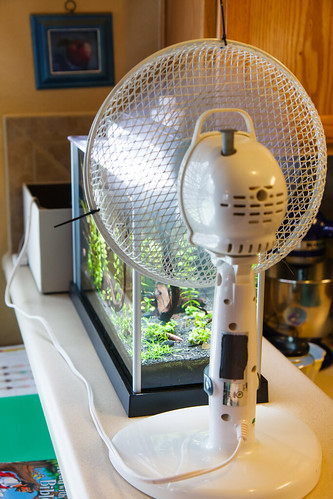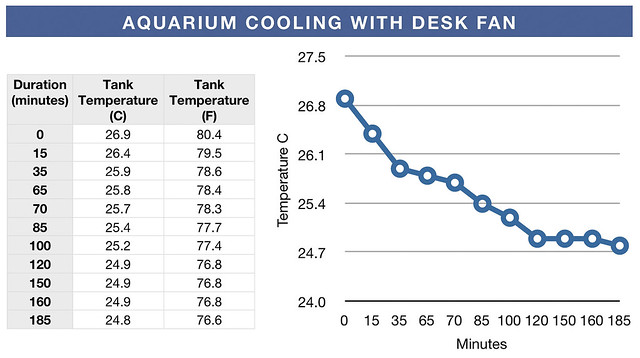This is the first full year that our aquarium has been up and running, so we are learning new things every month. What we have learned at the start of this summer is that we are having a hard time beating the heat, and are loosing control of the temperature in our aquarium. We don’t keep our home very cool, often letting the temperature drift up to upper 70’s (ºF). I was anticipating that the tank would stay a temperature close to the house ambient. This turned out to be wrong.
You can expect that your aquarium temperature will drift higher than the ambient temperature of your home. Pumps are water cooled and so that heat gets put back into the water. For planted or marine aquariums, the lighting load can be very high and much of that heat is transferred into the water as well. The end result for us is that the aquarium temperature was drifting to near 81ºF (27.2ºC), quite a bit higher than my desired range of 76ºF to 78ºF (24.4ºC to 25.6ºC). The fish and shrimp can probably survive with temperature swings this high, but doing this every day I felt would lead to an unhealthy aquarium and sick and dying fish.
Options for Cooling an Aquarium:
There are several methods available to cool an aquarium and they range from simple to complex (and expensive).
- Chillers. This is a box separate from your aquarium that actively lowers the temperature of the water. They are basically refrigerators that circulate aquarium water through to lower the water temperature. These devices vary greatly in capacity and price, but they are generally expensive. This is the go-to method for cooling a marine aquarium as the stakes are higher with all of the expensive critters. The downside for using a chiller for a nano aquarium is that most chillers are ‘in-line’ and intended to be plumbed separate from the aquarium, parallel to the canister filter or sump. It may be challenging to get a chiller sized small enough for a nano aquarium
- Ice bottles. I have heard this as an emergency fix to a hot aquarium. You can prepare bottles of ice water beforehand and float them in your aquarium if the temperature gets too high. The disadvantage to this is you don’t have much control over them temperature drop – you would want to watch how low it drops and take out the ice when you get to your desired temperature. The main shortfall is that you have to be around to notice the temperature is high and drop the ice bottles in yourself. There is not much convenience here as you have to babysit the tank, but it might be good in an emergency.
- Fans. You can use a fan blowing across the surface of your aquarium water to utilize evaporative cooling to drop the temperature of your tank water. This approach is very simple; the equipment is straightforward and relatively cheap. Fans can be selected that are relatively quiet.
How Does Evaporative Cooling Work:
Evaporative cooling is a concept that is, at first, a bit hard to understand. It is more than just moving heat off the surface of the water. The key to how an aquarium cooling fan can lower your tank temperature is by the phase change (from liquid to gas) that occurs when water is evaporated from the surface. By blowing a fan across the surface, evaporation is increased. The magic happens during this phase change – water releases much more energy when it transitions across the line from water to vapor. There are several ways you can understand this concept. If you lived in a dry enough are of the country where ‘swamp’ coolers were used in houses, this is the same concept. Even simpler is the sensation of getting out of a pool on a hot, windy day. Evaporating water off your body cools you off quickly.
Evaporative Cooling Test:
It’s easy to understand in theory, but to actually believe it, I had to give it a test myself. What is hard to believe is that you can get the tank temperature lower than the ambient air temperature. Our home often get’s close to 80ºF and I want to lower the temperature in the aquarium down to 76ºF (24.4ºC).
I already have built a temperature controller that has separate outlets for heating and cooling, so it would be easy to use. Just plug a fan of some sort into the cooling control and have it cycle the fan on and off. For an initial test and to help out in the short run with the high temperatures, I decided to just use a desk fan and point it to blow across the top of the aquarium. Not very ascetically pleasing, but a fan is a fan.
My temperature controller has an accurate current temp display and I decided to run a test and record the temperatures over time. The results from that initial test are in the table below (click to enlarge):
I was floored with the results. The ambient at the time of test was around 78ºF to 79ºF(25.5ºC to 26.1ºC) – tough conditions when trying to get the tank temperature down to 76ºF. On top of that the lights (medium light setup from a Finnex FugeRay Planted + LED light) were on and adding to the heat. Immediately after connecting the fan to the temperature controller, it energized and went to work. The temperature dropped like a rock right off the bat. It flattened out a bit at the end, but the tank was cooled from 80ºF (26.7ºC) down to 76.6ºF (24.7ºC) in only 3 hours. That may seem slow, but that is a worst case scenario being that it started with such an elevated temperature.
I have kept the fan in place over a week now, and the temperature has remained rock steady over all conditions, morning to very hot evenings. I can’t believe how well this setup can control. The only downside, and this is true for any fan cooling system, is that evaporation is much faster. The water level in our 5 gallon Spec drops from full to almost down to the bottom of the return grates within a week. Because I have modified the aquarium to plug the bypass opening, it’s especially important to remember to top off the aquarium with make-up water.
The Next Step for a Cooling Solution:
Now that I know evaporative cooling using a small fan will work for our small tank, I’m looking for a more ascetically pleasing solution than a desk fan on the bar. I have a few ideas including modifying the acrylic cover and placing a small computer fan on the lid. I’m not ruling out using a small clip on type fan if I can find one that will work better. I will post the final solution when I figure it out.





This was very helpful. Thank you for showing thee data. Keep up the good work!
Have you tried this test without any light over the aquarium? I am wondering if the fan may be reducing the water temperature because it is blowing from the heat emitted from the light away from the water, instead of reducing the water temperature through evaporation.
I haven’t graphed the results, but I have observed the exact same thing. Heat is reduced with a fan blowing over the surface, even without the light on.
Why would you wait a week before topping off the tank if you see that much evaporation?
goodness. I don’t wait for it to get that low – I was trying to explain that the evaporation rate is such that after a week or so you will see a significant drop in tank level.
Thank you for the information about evaporative cooling. I have now found that even using a small fan on low blowing only over the hanging filter’s vent holes is enough to radically reduce the aquarium temperature. I bought a “Hydro Crunch” thermostat for less than $25 (https://www.homedepot.com/p/Hydro-Crunch-Temperature-Controller-Digital-Outlet-Heat-Mat-Thermostat-with-Heating-and-Cooling-Mode-D940010600/303421535), set it, and the fan turns on and off automatically. Wonderful and easy solution. Thanks again!
Nice. It’s amazing what a little air can do to cool these aquariums down.
did you do this with the top lid on, or off? (If your tank even has a lid!) I can’t quite see it on the picture and wanted to know, so i could try the same thing. Thank you so much for this! Summer has been rough on my tank.
I’ve used the fan with both the top on and off. Possibly a little more efficient with the top off, but it works either way.
What size tank did you used to perform for test? I have a 30 gallon tank and have installed two lion fans and the temperature did not decrease, actually it increased.
I used it on the tank pictured (a 5 gallon nano). I have also used it on a 13.5 gallon saltwater nano. It will work on any size tank provide you have enough airflow (that is directed at the water surface) and it helps to have good water circulation.
If you added fans and observed the temperature rising because of the fans . . . you have a very special tank.
What size aquarium did you used? I have been trying to lower my temperature on a 30 gallons aquarium, bt the temperature keeps rising especially in the night bu 7 degrees. I have used an Ink Bird Temperature controller and no luck.
Karl – I answered some of your questions previously. I use very small USB powered fans. (1) fan on our 5 gallon freshwater and (2) fans on our 13 gallon saltwater. For a larger body of water, you might need more fans or larger fans. Make sure your fans are pointed down to blow across the water surface.
Just as a check, since the temperature is not within setpoint (above), I take it the fans are continuously running? What is your ambient temperature and what water temperature are you trying to maintain?